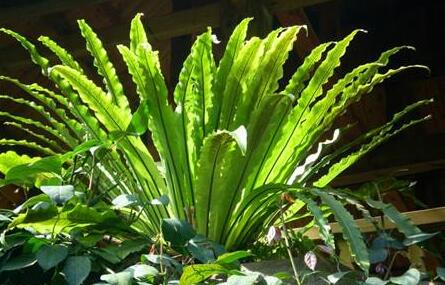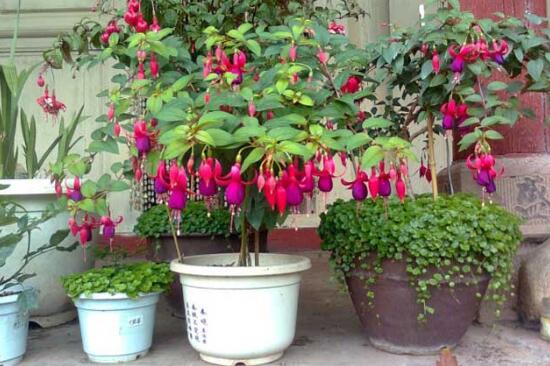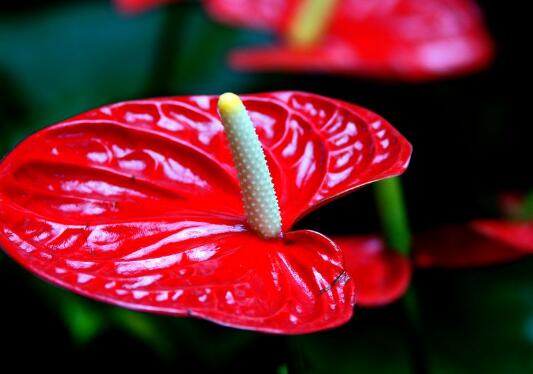How to deal with the yellowing of bird's nest fern leaves? four reasons need to be understood / attached.
The function of bird's nest fern includes six kinds, one of the most important functions is to observe leaves, its leaf length can reach 75 cm, so it is considered by many flower lovers to be one of the plants with the most ornamental leaf value, but if it is not maintained properly, it is also possible to cause the leaves to turn yellow, so the ornamental quality will be significantly reduced. How to deal with the yellowing of bird's nest fern leaves? Let's take a look at the reasons and methods of the editor's arrangement.
How to deal with the yellowing of bird's nest fern leaves
1. Overwatering

The reason: the bird's nest fern likes a humid environment, so it is inevitable to water it when planting, but if it is watered frequently and used too much, the soil will be too wet for a long time, and the lack of air in the soil will cause the roots to be unable to breathe. as a result, it becomes rotten and causes yellowing.
Method: watering should be reasonably watered according to the dryness and wetness of the soil, so how often do bird nest ferns be watered? During the growing period, it is usually watered every 3-5 days, and every 2-3 days in summer, but it needs to be stopped in winter and cannot be watered blindly and frequently.
2. Lack of nitrogen fertilizer.
Reason: nitrogen is the main component of chlorophyll in leaves. If nitrogen is absorbed in the soil and nitrogen fertilizer is rarely applied, it will cause the bird's nest fern leaves to lack nutrients and become thin, thin and yellowing.
Method: how to deal with the yellowing of bird's nest fern leaves caused by lack of nitrogen fertilizer? Change the soil in time, replace it with fertile heart soil, and then increase the amount of nitrogen fertilizer, each fertilization should be based on thin liquid fertilizer to avoid the lack of nitrogen fertilizer in the soil again.
3. Sunburn
Reason: many flower lovers should know that bird's nest fern is a plant that is not very tolerant to strong light. It can be preserved in the sun in spring and autumn, but if it is exposed to the sun in summer, its glossy leaves will soon turn yellow due to lack of water. This is also a possible phenomenon in many plants.
Method: first move the bird's nest fern to a cool place, cut off the leaves that have been yellowed and scorched, and then spray an appropriate amount of water, and then strengthen maintenance and management. You must not put them directly in the sun in summer, and shade measures should be taken as far as possible, such as building a shade shed and so on.
4. Improper temperature
Reason: if the temperature is too low in winter and we do not keep warm for the bird's nest fern, then its leaves will be frostbitten, one of the symptoms is yellowing, and will fall off early. If the temperature exceeds 30 degrees in summer, its leaves may also turn yellow, because it is easy to stagnate.
Solution: if the leaves are yellowing caused by temperature, the solution is naturally to control the temperature. Keep the temperature above 5 degrees in winter and below 30 degrees in summer. The more common way is to put on a thermal insulation film in winter. Spray water to cool or move to a cool place in summer.
How to deal with the yellowing of bird's nest fern leaves
The reason for the yellowing of bird's nest fern leaves-lack of water or too much water
Lack of water will cause the leaves of the bird's nest fern to turn yellow, because the leaves of the bird's nest fern tend to curl at the edges and turn yellow gradually when the soil is short of water or the air is relatively dry. And too much water will produce the phenomenon of stagnant water in the basin soil, dull bird nest fern leaves yellowing, and even rotten roots.
When watering the bird's nest fern, it should be noted that it is generally necessary to ensure that the basin soil is moist and has high air humidity. It should be fully watered in the growing season, and spray water to the leaves in time in summer, and it is best to spray more water and less water when it is low in winter. But in the rainy season, to avoid watering, winter, to avoid too much water and rotten roots and leaves yellow.
The reason for the yellowing of the leaves of bird's nest fern-lack of light
Lack of light can also easily lead to yellowing of bird's nest fern leaves, because leaving bird's nest ferns indoors for a long time discriminates against not having enough access to one, while the leaves turn yellow. But the light can not be too strong, it will also make the leaves yellow. Therefore, when breeding, it should be placed in a place with bright indoor light, not long-term concealment, and shade is needed in summer.
The reason for the yellowing of bird's nest fern leaves-- improper fertilization
When the plant of the bird's nest fern lacks fertilizer, or fertilizes too many times, it will lead to the yellowing of the leaves of the bird's nest fern. Therefore, when potted bird nest fern is planted, it is necessary to fertilize reasonably during its growth period, and to ensure a balance of various elements, but stop fertilizing when it is hot in summer and low in winter.
The reason for the yellowing of bird's nest fern leaves-- improper temperature
Improper temperature, for example, when the winter temperature is too low, the plants of the bird's nest fern will be frostbitten and the leaves will turn yellow. in addition, if the long-term sunlight is too strong and the temperature is too high, the leaves will also turn yellow.
Therefore, it is necessary to maintain the appropriate temperature during the growth period, between 15 ℃ and 28 ℃, and when the temperature is above or below this range, measures need to be taken.
The reason for the yellowing of bird's nest fern leaves-- the basin soil needs to be replaced.
If the soil in which the bird's nest fern grows has not been changed for a long time and the basin has not been changed for a long time, the soil will gradually solidify and be airtight, which can easily make its leaves yellow.
So spray love bird's nest fern needs to change the basin every two years, when changing the basin can remove the old soil, and trim the roots and yellow leaves.
The reason for the yellowing of bird's nest fern leaves-- diseases and insect pests
When the bird nest fern is damaged by nematode disease or anthrax, it can cause the bird nest fern leaves to turn yellow or appear disease spots. If it is nematode disease, you can use carbofuran granules to kill insects, if it is anthrax, you can use
75% of chlorothalonil wettable powder was sprayed.
What if the leaves of the bird's nest fern turn yellow? how to deal with it?
Bird's nest ferns are often attached to tree trunks or rocks in rainforests or seasonal rainforests. The nest of the cluster can hold a large number of dead branches and leaves, bird droppings and Rain Water, which are converted into humus and can be used as their own nutrients, as well as other tropical epiphytic plants, such as orchids and other tropical epiphytic ferns. Its ecological habit is that it likes high temperature and humidity and is not resistant to strong light. If it is not handled properly in breeding, the leaves of bird's nest ferns will turn yellow.
Causes and treatment methods of yellowing of bird's nest fern leaves 1. Yellowing of bird's nest fern leaves: insufficient or too much water
Lack of water will cause the leaves of the bird's nest fern to turn yellow, because the leaves of the bird's nest fern tend to curl at the edges and turn yellow gradually when the soil is short of water or the air is relatively dry. And too much water will produce the phenomenon of stagnant water in the basin soil, dull bird nest fern leaves yellowing, and even rotten roots.
When watering the bird's nest fern, it should be noted that it is generally necessary to ensure that the basin soil is moist and has high air humidity. It should be fully watered in the growing season, and spray water to the leaves in time in summer, and it is best to spray more water and less water when it is low in winter. But in the rainy season, to avoid watering, winter, to avoid too much water and rotten roots and leaves yellow.
Treatment method: potted bird nest fern requires not only wet pot soil, but also high relative air humidity. The growing season should be fully watered, especially in summer, in addition to the cultivation substrate should be often watered, the foliage must be washed 2 to 3 times a day, and the surrounding ground should be sprinkled to humidify, so as to maintain a high air humidity in the local environment and increase the light of the foliar surface. When the temperature is low in winter, it is better to keep the basin soil moist, spraying more water and watering less, so as to avoid rotting roots caused by too much water in the basin soil at low temperature. Water as little as possible during the rainy season.
2. The leaves of bird's nest fern turn yellow: lack of light.
Lack of light can also easily lead to yellowing of bird's nest fern leaves, because leaving bird's nest ferns indoors for a long time discriminates against not having enough access to one, while the leaves turn yellow. But the light can not be too strong, it will also make the leaves yellow. Therefore, when breeding, it should be placed in a place with bright indoor light, not long-term concealment, and shade is needed in summer.
Treatment: shade should be carried out in summer, or placed in a sparse shade under a big tree to avoid strong direct sunlight, which is conducive to growth and make the leaves glossy. Put it in a brightly lit place indoors, not in the dark for a long time. It should be moved into the greenhouse in winter and the temperature should be kept above 16 ℃ so that it can continue to grow, but the lowest temperature should not be lower than 5 ℃.
3. The leaves of bird's nest fern turn yellow: improper fertilization
When the plant of the bird's nest fern lacks fertilizer, or fertilizes too many times, it will lead to the yellowing of the leaves of the bird's nest fern. Therefore, when potted bird nest fern is planted, it is necessary to fertilize reasonably during its growth period, and to ensure a balance of various elements, but stop fertilizing when it is hot in summer and low in winter.
Treatment method: potted bird's nest fern should be irrigated with balanced thin fertilizer of nitrogen, phosphorus and potassium once a month in the vigorous growing season, which can promote it to grow a large number of new leaves. The temperature in summer is higher than 32 ℃, and the temperature in greenhouse is lower than 10 ℃ in winter. All forms of topdressing should be stopped.
4. The leaves of bird's nest fern turn yellow: the temperature is inappropriate.
Improper temperature, for example, when the winter temperature is too low, the plants of the bird's nest fern will be frostbitten and the leaves will turn yellow. in addition, if the long-term sunlight is too strong and the temperature is too high, the leaves will also turn yellow.
Therefore, it is necessary to maintain the appropriate temperature during the growth period, between 15 ℃ and 28 ℃, and when the temperature is above or below this range, measures need to be taken.
Treatment method: the suitable temperature for its growth was 16 ℃ to 27 ℃, 22 ℃ to 27 ℃ from March to October and 16 ℃ to 22 ℃ from October to March of the following year. In summer, when the temperature is more than 30 ℃, it is necessary to build a shed to shade and give the ring.
5. The leaves of the bird's nest fern turn yellow: the basin soil needs to be replaced.
If the soil in which the bird's nest fern grows has not been changed for a long time and the basin has not been changed for a long time, the soil will gradually solidify and be airtight, which can easily make its leaves yellow.
So spray love bird's nest fern needs to change the basin every two years, when changing the basin can remove the old soil, and trim the roots and yellow leaves.
Treatment method: the pot substrate can be mainly composed of rotten leaf soil or peat soil, vermiculite, mixed with a small amount of river sand, or mixed with fern root, broken bark, moss or broken brick grains and a small amount of humus soil. Potted bird's nest fern can be changed every 2 years, take it out of the flowerpot, shake off the persistent soil, cut off some of the residual roots and withered yellow leaves, and plant the peeled offspring.
6. Yellowing diseases and insect pests in the leaves of bird's nest fern
When the bird nest fern is damaged by nematode disease or anthrax, it can cause the bird nest fern leaves to turn yellow or appear disease spots. If it is nematode disease, you can use carbofuran granules to kill insects, if it is anthrax, you can use
75% of chlorothalonil wettable powder was sprayed.
Treatment method: for the harm of nematodes, Kexidan or carbofuran particles can be used to spread on the surface of basin soil, and the insecticidal effect is better. In addition, gnawing leaves such as short-fronted locusts and snails should be controlled in time. For anthrax, 75% chlorothalonil wettable powder 600 times or 70% methyl topiramate wettable powder can be used at the initial stage of the disease.
- Prev

What if the lantern leaves fall off, replenish nutrients / stop watering / suitable temperature and light
To cultivate flowers, to cultivate interest, but also to cultivate skills. Keeping lantern flowers at home is the choice of many flower friends, but in the process of breeding, for some reasons, their lantern flowers will show all kinds of discomfort, such as falling leaves. What if the lantern leaves fall off? In this regard, the editor summarized five reasons.
- Next

How to do the yellow leaves of flamingo flowers, pay attention to shade/thin fertilizer application/prevention of pests and diseases
Flamingo flower is an ornamental flower plant, it has Buddha flame inflorescence, leaf bracts, give a warm feeling like fire, so by many people's favorite. However, if the leaves of plants in the United States are yellow, it will also affect their overall beauty. What about the yellow flamingo leaves?
Related
- Fuxing push coffee new agricultural production and marketing class: lack of small-scale processing plants
- Jujube rice field leisure farm deep ploughing Yilan for five years to create a space for organic food and play
- Nongyu Farm-A trial of organic papaya for brave women with advanced technology
- Four points for attention in the prevention and control of diseases and insect pests of edible fungi
- How to add nutrient solution to Edible Fungi
- Is there any good way to control edible fungus mites?
- Open Inoculation Technology of Edible Fungi
- Is there any clever way to use fertilizer for edible fungus in winter?
- What agents are used to kill the pathogens of edible fungi in the mushroom shed?
- Rapid drying of Edible Fungi

